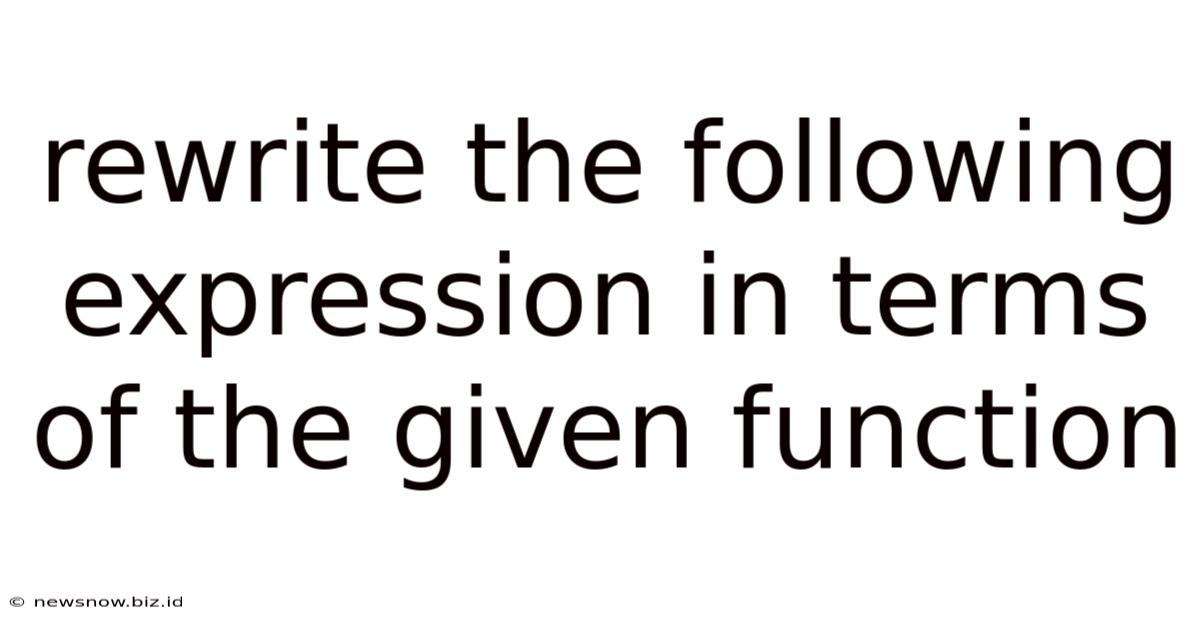Rewrite The Following Expression In Terms Of The Given Function
New Snow
May 11, 2025 · 5 min read

Table of Contents
Rewriting Expressions in Terms of Given Functions: A Comprehensive Guide
Rewriting expressions in terms of given functions is a fundamental skill in mathematics, particularly in calculus, algebra, and various branches of engineering. It involves manipulating an expression to express it solely using a specific function and potentially its derivatives or integrals. This process simplifies complex expressions, reveals underlying relationships, and allows for easier manipulation and analysis. This comprehensive guide will explore various techniques and strategies for rewriting expressions using given functions, encompassing a wide range of examples and problem-solving approaches.
Understanding the Core Concept
The core idea is to identify relationships between the given function and the expression you need to rewrite. This often involves recognizing patterns, applying algebraic manipulation, and utilizing trigonometric or other mathematical identities. The goal is to substitute parts of the original expression with equivalent expressions involving the given function, ultimately leading to an expression solely in terms of that function.
Essential Techniques and Strategies
Several key strategies are frequently employed when rewriting expressions in terms of given functions. Let's delve into each one:
1. Substitution
Substitution is the most common approach. It involves identifying a part of the expression that can be directly replaced with the given function or a simple transformation thereof.
Example:
Let's say the given function is f(x) = x² + 1 and the expression to rewrite is g(x) = (x² + 1)² + 2(x² + 1) - 3.
Notice that x² + 1 appears in g(x). We can substitute f(x) directly:
g(x) = [f(x)]² + 2[f(x)] - 3
This successfully rewrites g(x) in terms of f(x).
2. Algebraic Manipulation
Sometimes, a direct substitution isn't immediately apparent. In such cases, algebraic manipulation—including factoring, expanding, completing the square, and using partial fractions—is crucial.
Example:
Given f(x) = √(x + 1) and g(x) = x + 2√(x + 1) + 1.
We can rewrite g(x) as:
g(x) = x + 1 + 2√(x + 1) + 1
Notice that x + 1 is within the square root in f(x). We can rewrite:
g(x) = [f(x)]² + 2[f(x)] + 1
This simplifies to:
g(x) = [f(x) + 1]²
Now g(x) is expressed solely using f(x).
3. Trigonometric Identities
When dealing with trigonometric functions, leveraging trigonometric identities is paramount. These identities allow for the conversion between different trigonometric functions and their manipulations.
Example:
Given f(x) = sin(x) and g(x) = cos²(x). Using the Pythagorean identity sin²(x) + cos²(x) = 1, we get:
cos²(x) = 1 - sin²(x)
Therefore:
g(x) = 1 - [f(x)]²
4. Derivative and Integral Relationships
In calculus, rewriting expressions might involve using the derivative or integral of the given function.
Example:
Given f(x) = eˣ and g(x) = eˣ + 2xeˣ. We know that the derivative of eˣ is eˣ. Hence:
g(x) = f(x) + 2x * f(x) = f(x)(1 + 2x)
5. Chain Rule and Inverse Functions
The chain rule plays a crucial role when dealing with composite functions. Understanding inverse functions is also essential for rewriting certain expressions.
Example:
Given f(x) = ln(x) and g(x) = ln(x³ + 1). If we let u = x³ + 1, then g(x) = ln(u). Since f(x) = ln(x), we can't directly substitute. However, understanding the relationship is key. We cannot easily express g(x) solely in terms of f(x) without further context or manipulation.
Advanced Techniques and Applications
Beyond the basic techniques, certain problems require more advanced approaches:
-
Partial Fraction Decomposition: This technique is helpful when dealing with rational functions. It involves breaking down a complex rational function into simpler fractions that can be expressed in terms of the given function.
-
Series Expansions: Utilizing Taylor or Maclaurin series expansions can provide approximations that allow for rewriting complex expressions in terms of simpler functions, especially when dealing with transcendental functions.
-
Differential Equations: In some cases, the relationship between the expression and the given function might be defined implicitly through a differential equation. Solving this equation can lead to an explicit expression of the function in terms of the given one.
-
Numerical Methods: For complex scenarios where an analytical solution is difficult or impossible to find, numerical methods such as Newton-Raphson or iterative approaches can provide approximate solutions for rewriting the expression in terms of the given function.
Common Pitfalls and Troubleshooting
-
Incorrect Simplification: Ensure all algebraic manipulations and simplifications are correct to avoid errors. Double-checking your work is crucial.
-
Overlooking Identities: Remember to utilize relevant trigonometric, logarithmic, or exponential identities to facilitate the rewriting process.
-
Incorrect Substitution: Carefully identify the correct parts of the expression to substitute. Mistakes in substitution can lead to incorrect results.
-
Ignoring Constraints: Be mindful of the domain and range of the given function and ensure any substitutions or manipulations don't violate these constraints.
Conclusion
Rewriting expressions in terms of given functions is a multifaceted skill requiring a blend of algebraic dexterity, knowledge of mathematical identities, and an understanding of calculus concepts. Mastering these techniques significantly enhances your ability to simplify complex expressions, reveal underlying relationships, and solve a broader range of mathematical and engineering problems. By diligently practicing the techniques outlined and addressing potential pitfalls, you can build a strong foundation for tackling such problems with confidence and efficiency. Remember that practice is key to mastering this valuable skill. Start with simpler problems and gradually progress to more complex ones, continuously reviewing and reinforcing your understanding.
Latest Posts
Related Post
Thank you for visiting our website which covers about Rewrite The Following Expression In Terms Of The Given Function . We hope the information provided has been useful to you. Feel free to contact us if you have any questions or need further assistance. See you next time and don't miss to bookmark.